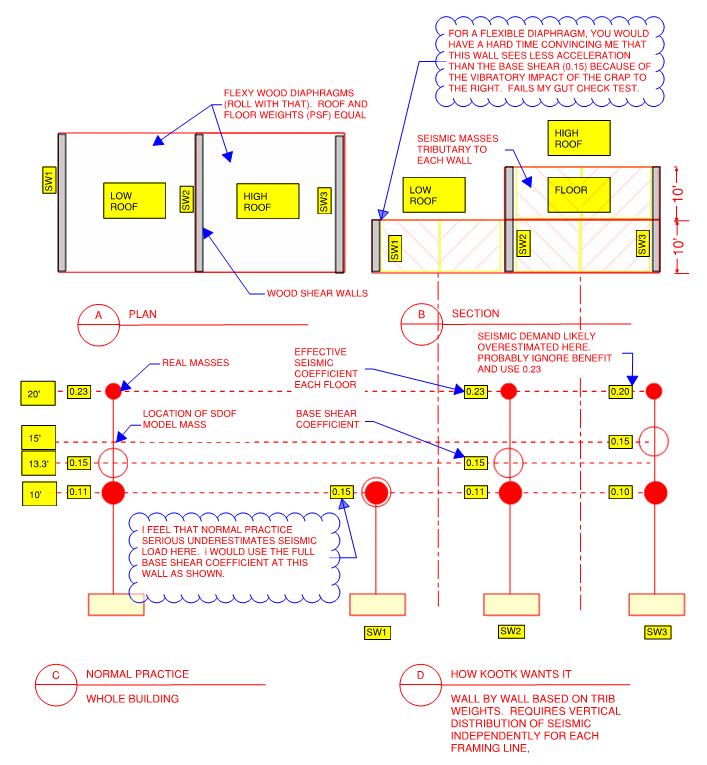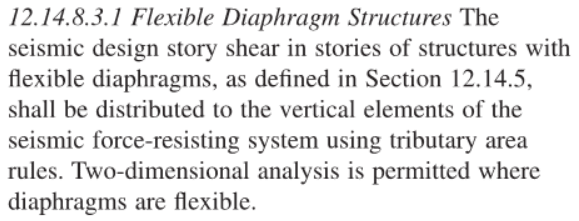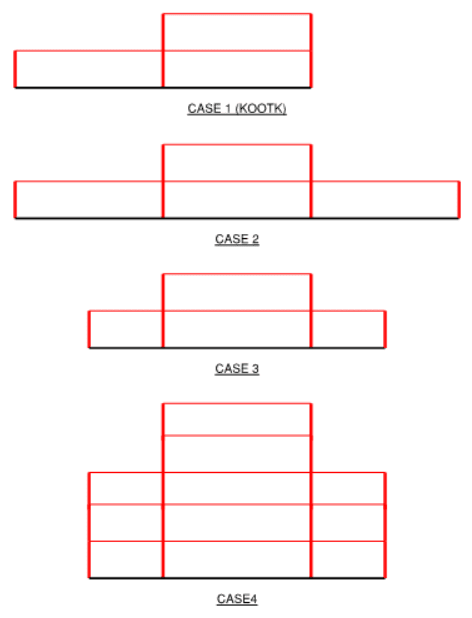Deker said:
For those who would tend to design based on KootK's detail D, does that hold true for any configuration with flexible diaphragms?
Yes.
Deker said:
Or is it more of a judgement call based on the proportions presented in the original sketch?
Certainly, more extreme situations nag at my gut feel for the situation more than others. A 50'x50' L2 over a 50'x65' L1 gives me no grief. For the actual building that I'm working on, which is close in proportion to your case 1, my visceral response to the thing is that little of the Cs response should be getting "siphoned" away to the multi-story part of the building. That, particularly, given that my low roof has gravel & pavers making that area a more mass intensive than the rest.
It's a weird thing though. I'm highly analytical by nature. Once I put myself in the zone with respect to "flexible diaphragm" it's hard for me to turn it off and remain objective.
Deker said:
What about for the configurations shown below?
All four for me. Case four is particularly bothersome. With the two stories, I'm confident that all of the walls will have very short periods and that the risk of inducing meaningfully different vibratory responses among the walls is small. As it gets taller, I start to worry more about individual walls doing their own seismic dance as it were. The higher up in the air a diaphragm is, the more I like it to be rigid.
Deker said:
KootK...one other thing to consider...will you be providing special detailing to break your diaphragm chords at the interior shearwall?
Are you being facetious? I can't tell. I've never even heard of such detailing. And I wouldn't be providing it either way. I'm very much in the old school camp where tying every damn thing together as much as possible is a virtue to be discarded with care.
Deker said:
If not, how will you distribute the seismic mass of the 2nd floor / low roof to your shearwalls? Will you follow standard practice and use tributary areas (25/50/25)? Or will you consider diaphragm continuity (19/62/19)? Or will you bracket the two (25/62/25)?
25/50/25. It's worth noting that the true shear deformation of the diaphragm actually does tend to respond this way so 19/62/19 is a non-possible. I take your point though.
Rest assured that I've not allowed myself to get bogged down with this. It's more a matter of curiosity. As I was executing my design, I simply had an a-ha moment where I suddenly felt it ridiculous to be designing the far wall for less that Cs. And it's been beneficial for me to find out that, at the least, others have been thinking the same thoughts.
What I actually did for the project du jour is this:
1) Assumed the SDOF to be at the low roof level for working out the upper level contribution to the shear walls. F2/W = 0.31 ~ 2 x Cs. No meaningful penalty.
2) Assumed the SDOF to be at the low roof level for working out the lower level contribution to the shear walls F1/W = 0.15 = Cs
3) Dialed back the upper floor contribution to the lower level walls such that the base shear at each wall is correct at (F2_+ F1)/W = Cs
It sounds like a mouthful but was actually super easy to execute. It's also reliably conservative, but not excessively so, in my opinion.
Deker said:
I know you understand this, and I only bring it up to reemphasize that the force level we use for seismic design is far, far less important than the detailing.
Yes and no. In my particular example, the effect would be to shave off about 25% of the shear to some of the low walls. And while I believe that wood buildings are ductile in aggregate, I've not found the ductility of individual walls and their connections to be that convincing. Of course, if I had my druthers, nothing in the realm of single family timber residences would be getting engineered to begin with. Rough stuff indeed.
HELP! I'd like your help with a thread that I was forced to move to the business issues section where it will surely be seen by next to nobody that matters to me:




